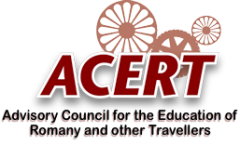Richard Kerridge, History Subject Adviser at the Examining Board OCR, asked the ACERT Education Network to join him in pressing for a more representative curriculum when he spoke to our meeting on 26th April. In many areas, Gypsies, Roma and Travellers are often the largest minority group but they will not find themselves reflected in the curriculum.
Previously, Richard was a History teacher in Mildenhall and Ipswich, and as a fellow of the History Association (to which most History teachers belong) he developed a range of resources for teaching the history of Gypsy, Roma and Traveller people with Helen Snelson, PGCE History Curriculum Leader at the University of York and the historian Professor Becky Taylor.
Detailed lesson plans and adaptable teaching materials are freely available on the York CLIO website. There is a four lesson sequence that focuses on the history of Gypsies and Travellers from the start of the first industrial revolution period to the eve of the First World War. This is an appropriate focus for the KS3 curriculum There is also an explanatory article on the importance of including Gypsy, Roma and Traveller perspectives across the curriculum. There are also has a comprehensive collection of links to useful resources and podcast tasters.

Richard is keen to meet with ACERT members who are interested in developing and sharing materials across the curriculum.


.jpeg)


